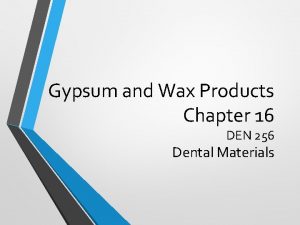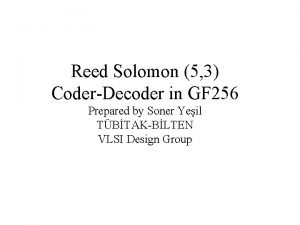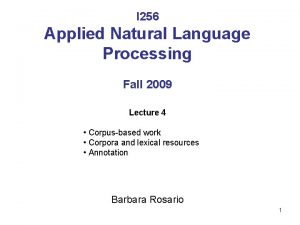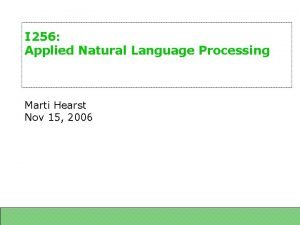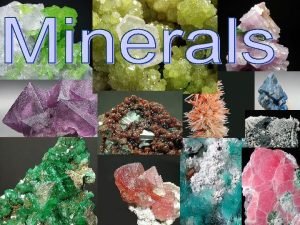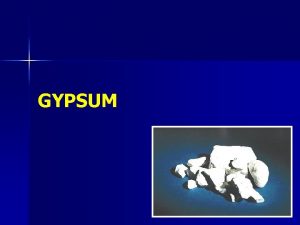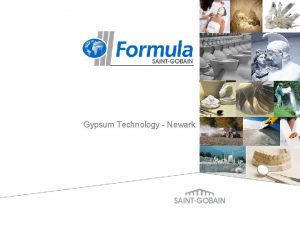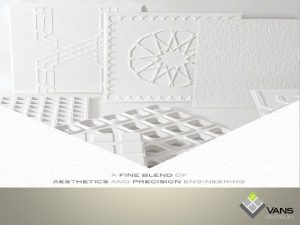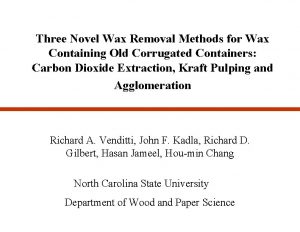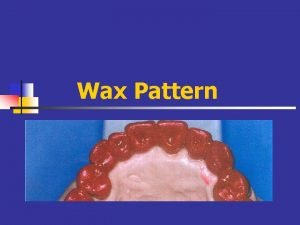Gypsum and Wax Products Chapter 16 DEN 256































- Slides: 31

Gypsum and Wax Products Chapter 16 DEN 256 Dental Materials

Lesson 16. 1 Gypsum and Wax Products 1. Differentiate between negative and positive reproduction. 2. Differentiate among diagnostic cast, working cast, and dies. 3. Describe the chemical and physical nature of gypsum products. 4. Explain the manufacturing process for gypsum products and how this affects their physical characteristics. 5. Compare the following properties and behaviors of gypsum products: strength, dimensional accuracy, solubility, and reproduction of detail. 6. List the American Dental Association–recognized gypsum products and their most appropriate uses. 2 Copyright © 2016 by Saunders, an imprint of Elsevier Inc. All rights reserved.

Lesson 16. 1 Gypsum and Wax Products 7. Explain initial and final set of gypsum and the factors that affect the setting time, setting expansion, and strength. 8. Explain the procedure for mixing and handling gypsum products to create diagnostic casts. 9. Identify the common components of dental waxes. 10. Compare the properties of waxes. 11. Describe the clinical/laboratory significance of each of the properties of waxes. 12. Discuss the three classifications of waxes. 3 Copyright © 2016 by Saunders, an imprint of Elsevier Inc. All rights reserved.

Lesson 16. 1 Gypsum and Wax Products 13. Differentiate between direct and indirect waxings and identify which property of dental waxes is most important in their difference. 14. Describe the usual color, form, and use of inlay, casting, baseplate, boxing, utility, and sticky waxes. 15. Prepare model plaster or stone for pouring. 16. Pour the anatomic portion of maxillary and mandibular diagnostic casts. 17. Pour the base portion of maxillary and mandibular diagnostic casts. 18. Trim maxillary and mandibular diagnostic casts. 19. Obtain a bite registration using bite registration or utility wax. 4 Copyright © 2016 by Saunders, an imprint of Elsevier Inc. All rights reserved.

Uses and Desirable Qualities of Gypsum Products • Gypsum: • • Mineral that is widely found in nature Ideal for making replicas of the patient’s mouth • • • Diagnostic casts (also called study models) Working casts (also called working models) Dies • The replicas are called: 5 Copyright © 2016 by Saunders, an imprint of Elsevier Inc. All rights reserved.

Properties and Behaviors of Gypsum Products • Chemical properties • • • Mineral gypsum = dihydrate of calcium sulfate Ground to produce a powered hemihydrate Model plaster: Commonly used for diagnostic casts (study models) Dental stone: Used for working casts (master casts) Die stone 6 Copyright © 2016 by Saunders, an imprint of Elsevier Inc. All rights reserved.

Properties and Behaviors of Gypsum Products (Cont. ) • Physical properties • • Main differences in physical forms dependent on variations in size, shape, and porosity of the powders Strength, hardness, and resistance to abrasion • Strength of gypsum products related to the amount of water used to produce the study or working cast 7 Copyright © 2016 by Saunders, an imprint of Elsevier Inc. All rights reserved.

Properties and Behaviors of Gypsum Products (Cont. ) • Physical properties (Cont. ) • • • Dimensional accuracy • Control setting expansion Reproduction of detail Solubility 8 Copyright © 2016 by Saunders, an imprint of Elsevier Inc. All rights reserved.

Classification of Gypsum Products • Impression plaster (type I) • Rarely used today • • Frequently used for diagnostic casts Durable but relatively weak material • Model plaster (type II) 9 Copyright © 2016 by Saunders, an imprint of Elsevier Inc. All rights reserved.

Classification of Gypsum Products (Cont. ) • Dental stone (type III) • Ideal for making full or partial denture models, orthodontic models, and casts, whitening trays, sports guards, partials • Dental stone, high-strength/low-expansion (type IV) • • Often referred to as die stones or densite Used to fabricate crowns and bridges • Good to use with the newer base metals because of casting shrinkage • Dental stone, high-strength/high-expansion (type V) 10 Copyright © 2016 by Saunders, an imprint of Elsevier Inc. All rights reserved.

Manipulation of Gypsum Products • • • Material selection Proportioning (water-to-powder ratio) Mixing: Spatulation Initial setting time and working time Final setting time Control of setting times: • • Altering the water-to-powder ratio Spatulation Temperature Accelerators and retarders 11 Copyright © 2016 by Saunders, an imprint of Elsevier Inc. All rights reserved.

Manipulation of Gypsum Products (Cont. ) • Fabricating and trimming diagnostic/working casts • • Diagnostic and working casts have two parts: • • Anatomic portion Art portion Double-pour method Single-step method Boxing method 12 Copyright © 2016 by Saunders, an imprint of Elsevier Inc. All rights reserved.

Manipulation of Gypsum Products (Cont. ) • Storage • Gypsum products can absorb water from the environment • Gypsum should be stored in airtight, moistureproof containers • Humidity and close proximity to water sources will adversely affect the powder. 13 Copyright © 2016 by Saunders, an imprint of Elsevier Inc. All rights reserved.

Manipulation of Gypsum Products (Cont. ) • Cleanup • Bowls, spatulas, mechanical vibrators, and mixing devices should be cleaned of all traces of gypsum as soon as possible after manipulation 14 Copyright © 2016 by Saunders, an imprint of Elsevier Inc. All rights reserved.

Manipulation of Gypsum Products (Cont. ) • Trimming • • Cast or study model Model for whitening trays 15 Copyright © 2016 by Saunders, an imprint of Elsevier Inc. All rights reserved.

Manipulation of Gypsum Products (Cont. ) • Infection control and safety issues • Separating the impression from the cast • • Gently ease a lab knife under the impression tray and lift the tray slightly in several areas Care should be taken to not tilt too far in one direction or force the impression and cast apart • Broken teeth may result 16 Copyright © 2016 by Saunders, an imprint of Elsevier Inc. All rights reserved.

Manipulation of Gypsum Products (Cont. ) • Metal-plated and epoxy dies and resin-reinforced die stone • • Type IV and V gypsum products are commonly used die materials Silver or copper plating can create metal-plated dies that are highly resistant to abrasion 17 Copyright © 2016 by Saunders, an imprint of Elsevier Inc. All rights reserved.

Manipulation of Gypsum Products (Cont. ) • Investment materials: • Used to form metal castings through the lost wax technique 18 Copyright © 2016 by Saunders, an imprint of Elsevier Inc. All rights reserved.

Composition and Properties of Dental Waxes • Melting range: • Range of temperatures at which each component of the wax will start to soften and then flow • Flow: • Movement of wax as molecules slip over each other • Excess residue • Thermal expansion 19 Copyright © 2016 by Saunders, an imprint of Elsevier Inc. All rights reserved.

Manipulation of Waxes • Softening of wax should be done: • • Evenly in dry heat With warm hands With a warm water bath By flame • Store waxes at or slightly below room temperature to avoid distortion 20 Copyright © 2016 by Saunders, an imprint of Elsevier Inc. All rights reserved.

Classification of Waxes • Three classifications: • • • Pattern waxes Processing waxes Impression waxes • Sticks, sheets, blocks, and tins are used • Manufacturers produce these waxes in several forms: 21 Copyright © 2016 by Saunders, an imprint of Elsevier Inc. All rights reserved.

Classification of Waxes (Cont. ) • Pattern waxes • • Inlay wax –used to prepare patterns for metal casting Casting wax-used to construct the metal framework of partial and • Baseplate wax-used to make occlusion rims and to hold artificial teeth to baseplates during the fabrication of dentures. complete dentures -composed of beeswax, paraffin and color matter 22 Copyright © 2016 by Saunders, an imprint of Elsevier Inc. All rights reserved.

Classification of Waxes (Cont. ) • Processing waxes • • • Boxing wax • Used to form a box around impressions of the mouth when a cast is made Utility wax • • Comes in long ropes that are easily manipulated at room temperature May be used with boxing wax to aid in the pouring of an impression Sticky wax • Comes in orange sticks that at room temperature are hard and brittle, but when heated under flame become soft and sticky 23 Copyright © 2016 by Saunders, an imprint of Elsevier Inc. All rights reserved.

Utility Wax • to provide rim locks and otherwise to adapt impression trays for individual impressions • is pliable enough at room temperature to be used without heating. • normally is issued in stick form and usually is red. • 24 Copyright © 2016 by Saunders, an imprint of Elsevier Inc. All rights reserved.

Classification of Waxes (Cont. ) • Impression waxes • Corrective impression wax • Bite registration wax 25 Copyright © 2016 by Saunders, an imprint of Elsevier Inc. All rights reserved.

Why is it necessary to obtain a Bite Registration? Bite Registration • Provides the laboratory technician with a reproduction of a patient’s bite. • An opposing arch registration for designing the anatomic structures of the fixed prosthetic appliance or device Copyright © 2016 by Saunders, an imprint of Elsevier Inc. All rights reserved. Copyright © 2012, 2009, 2005, 2002, 1999, 1995, 1990, 1985, 1980, 1976 by Saunders, an imprint of Elsevier Inc. All rights reserved. 26

Bite Registration • 27 Copyright © 2016 by Saunders, an imprint of Elsevier Inc. All rights reserved.

• Flow material over the occlusal and incisal edges evenly, then have patient bite together in a normal occlusion. 28 Copyright © 2016 by Saunders, an imprint of Elsevier Inc. All rights reserved.

Bite Registration • 29 Copyright © 2016 by Saunders, an imprint of Elsevier Inc. All rights reserved.

Questions? 30 Copyright © 2016 by Saunders, an imprint of Elsevier Inc. All rights reserved.

Summary • Gypsum products are used to produce diagnostic and • working models of the patient’s hard and soft tissues The dental assistant and the hygienist may have occasion to use dental waxes in a variety of clinical and laboratory procedures, which makes a basic knowledge and understanding of the material important 31 Copyright © 2016 by Saunders, an imprint of Elsevier Inc. All rights reserved.
 Den gode den onde og den grusomme
Den gode den onde og den grusomme Den gode, den onde og den grusomme
Den gode, den onde og den grusomme Musik
Musik Ashutosh pai
Ashutosh pai Die stone composition
Die stone composition Gamle karakterskala til ny
Gamle karakterskala til ny In den kopf schauen
In den kopf schauen Hudba dohráva
Hudba dohráva Functional product
Functional product Coke vs pepsi sales
Coke vs pepsi sales Raiz quadrada
Raiz quadrada Resolución 256 de 2018
Resolución 256 de 2018 2^x=256
2^x=256 Ayatul birr
Ayatul birr 120 hangi onluğa yuvarlanır
120 hangi onluğa yuvarlanır 64+16+1
64+16+1 Gf(256)
Gf(256) 8 bits 256
8 bits 256 Sha256digest
Sha256digest El año sideral dura 365. 256 días solares medios
El año sideral dura 365. 256 días solares medios Vlookup reference error 256 columns
Vlookup reference error 256 columns I^256
I^256 All perfect square numbers
All perfect square numbers 256+93
256+93 Ist 256
Ist 256 I^256
I^256 Sha256
Sha256 Alas sebuah limas berbentuk persegi dengan luas 256
Alas sebuah limas berbentuk persegi dengan luas 256 Duygu çelik ertuğrul
Duygu çelik ertuğrul Copper mineral group
Copper mineral group Gypsum rock type
Gypsum rock type Silicate minerals in mohs scale
Silicate minerals in mohs scale




